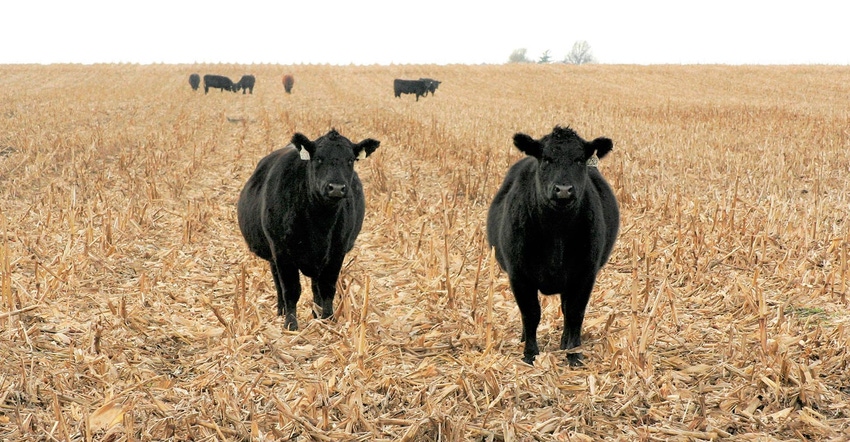September 15, 2020

This year, many corn and livestock growers turned to Eldon Cole, longtime University of Missouri Extension livestock specialist, to ask about grazing corn after the persistent drought in southwestern Missouri this season. He says cattle producers can graze drought-stricken corn, along with cornstalks. It is inexpensive, nutritious forage.
Cole says damaged corn makes suitable grazing for cattle — with some restrictions and a commitment to timely rotation to new pastures. He notes that farmers should test for nitrates before grazing corn, as there is a chance of increased nitrate poisoning during a drought.
One farmer’s experience
In July, Merle Schnelle, a row-crop farmer near Meinert, Mo., in Dade County, watched as his cornfield dried up from drought. The insurance adjuster estimated it would make only 4.5 bushels per acre. So, he called Cole for help.
Schnelle also is a cattle producer. He wanted to graze the drought-dried corn. He provided Cole with details about his cornfield. The plant population was 25,000 per acre, and he expected to make less than 5 bushels per acre. So, the two men devised a grazing plan.
Schnelle would offer his cattle 1 acre per day in the cornfield. About 80 of the 100 cows had spring calves on them, the remaining 20 would calve in the fall. He set 36-inch-high single-wire fence run by a solar charger. Before placing the wire, he mowed an open lane for the hot wire by running a 25-hp tractor with a 6-foot belly mower across the 40-acre field.
His cows adjusted quickly to moving daily to fresh, green corn. Cole says the herd seemed to thrive on the corn and left little waste.
Cattle benefit from cornstalk grazing
MU Extension beef nutritionist Eric Bailey says grazing cornstalks is a good, inexpensive option to extend the grazing season and fill forage gaps.
Cows are selective grazers, choosing the highest protein and most digestible parts first, Bailey says. First, they will eat corn grain, leaves, husks and finally stalks.
By eating the higher-protein parts of the corn first, cows may need little additional supplements. Energy is not limiting during the first 30 days of grazing. Protein will be limiting after 30 days on the same field at 0.5 pound of crude protein per cow per day. Consider herd needs as the needs of lactating and fall-calving cows or stocker calves may be greater, Bailey says.
Bailey uses a simple rule of thumb for quick estimates: Bushels per acre divided by 3.5 equals grazing days per acre for a 1,200-pound cow. For example, if the field produced 150 bushels per acre, then it would provide enough residue for 42 grazing days (150 divided by 3.5).
The more accurate estimate is to factor in residue produced per bushel of grain. There will be 16 pounds of leaf and husk residue per bushel of grain. In a 150-bushel-per-acre crop, there will be 2,400 pounds of dry feed per acre.
Assume 1 acre per cow per month and try to leave cows on the field less than two months, Bailey says. This estimate is more conservative than the previous one, but will keep cows from consuming the lowest-quality plant parts (stalks and cobs).
Some dry matter is lost to trampling or weathering, so assume 50 percent harvest efficiency, Bailey says.
Convenient portable fencing systems make strip-grazing easier now than in years past. By moving cows to the feed instead of taking feed to the cows, producers can save time and money.
A side benefit is that cows will return nutrients to the land in the form of manure. Another advantage is that cows will eat corn grain fallen on the ground, and this may reduce the amount of volunteer corn in a field the following year.
Bailey says grazing also can save producers money by avoiding shredding and baling costs. Sample and test bales for nutritional value. Test for protein and energy, and supplement as needed.
Source: University of Missouri Extension, which is solely responsible for the information provided and is wholly owned by the source. Informa Business Media and all its subsidiaries are not responsible for any of the content contained in this information asset.
You May Also Like




